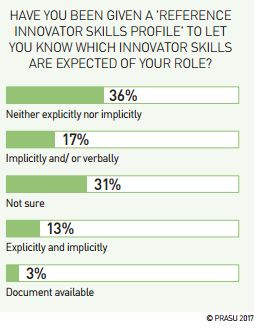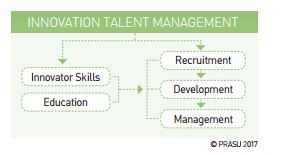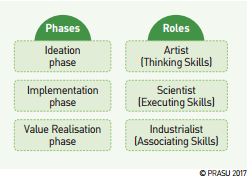Innovation — a talent management challenge

Innovation is a powerful growth driver for any industry, of any size and anywhere in the world. To continuously develop successful new products and services, organizations need a pipeline of innovations to select from, since every innovation cannot be successful in the market. To achieve this scale of innovation, organizations depend on its people to be efficient, successful innovators. Often, we hear this from employees we coach, “My role includes innovation as a part of my work. My KRA includes deliverables related to innovation and they are a part of my appraisal cycle too”.
However, there are three major challenges to this. The first challenge is that, firms need their people to be innovators to deliver innovations. But, across industry verticals, people struggle to deliver business relevant innovation. The main reason is that they have not learnt innovation and innovator skills in their formal education and have not been trained to be professional innovators. But, they are expected to be professional innovators and deliver innovations the firm needs. A software engineer studies programming languages in his formal education cycle, but nothing about how to be an innovator. A mechanical engineer learns how to design machines but not the skills of being a world-class innovator. Thus, delivering innovations and being professional innovators in this setup is not possible. In this context, everyone tries to do their best they can and most do it by trial and error. While trying to do so, there is a lot of unnecessary friction, burnout, avoidable failures, frustration and loss of opportunities for the employee as well for the organization.
The second challenge is that as leaders, we expect people to innovate but we often forget that there is a need for a proper job description that clearly reflects the expected skills, along with the roles and responsibilities of a professional innovator. To understand this better, let us look at how we hire talent. When hiring talent, for example, mechanical engineers, the business unit, and the HR develops a job description with the required educational qualification, domain experience along with the roles and responsibilities needed for the job. The HR partner then hunts for suitable profiles for the job based on this job description. However, the job description is at best fuzzy and not based on any scientific model linked to innovator skills. When you want to recruit ‘Innovators’, what would be the discussion between you and your HR partner? What will the job description comprise?

A whopping 73 percent of the respondents in our research reveal that disciplines like project management, software engineering or marketing have good models to manage the talent stream and the expected skills are listed. Further, people in such disciplines are mapped to junior or senior levels depending on the proficiency in these skills. For example, a team lead is expected to have planning and tracking ability, while a project manager is expected to have people management skills too. Further, a program manager is expected to additionally have negotiation skills and so on. Such a list of skills for an innovator is usually missing when hiring for innovators. This makes it virtually impossible for management to state which skills and what proficiency levels for such skills are expected and makes it difficult to scientifically differentiate a junior innovator from a senior innovator. A mere 3 percent of the respondents had an explicit document to show them as an innovator while about half of them said it is implicit or verbal.

The third issue is, organizations make the outcome of the efforts as innovators, a part of their appraisal cycle and obviously reward or penalize for performance or non-performance respectively. This is an unfair method to manage innovators since people are expected to do something which they are not trained to do. It is like asking a mechanical engineer to manage accounts, or asking a software engineer to manage operations and so on or like asking someone who doesn’t know how to cook, to cook. One can imagine the outcome.
Currently, such issues are poorly managed and the processes that exist are largely informal. Thus, a scientific model to manage the “innovation talent” is much needed in every organization for succeeding in the innovation journey. While enough and more has been said about the process part of innovation, the same is not true for the people part of it, the innovators.
It is not the presence of a qualitative description of an innovator but the absence of a quantitative description of the skills of an innovator linked to the innovation strategy of the organization which is the problem.

HR can play a critical role in setting this right, from the point of identifying innovators, their job description, assessment of innovators in line with the organization needs, development of innovators through to managing the innovators career, reward and recognition. There has to be a scientific model to support the organization to succeed in its innovation efforts. Let us look at each of these areas where HR can play a key role.
Recruiting Innovators
Recruitment of innovators includes both identification and assessment of innovators. Apart from the regular educational qualifications and professional experience, the skills of an innovator should be factored in for the role of innovators. Here is a crucial part — the innovation strategy and innovation gaps of the organization have to be understood first. Such gaps vary from organization to organization and it depends on the phases of innovation where the firm is actively focusing on.

A typical innovation journey has three phases — Ideation, Implementation and Value Realization phases. Each phase of innovation expects a different role to be played by the innovator. A successful innovator has a role to play in each of these phases, as an Artist in the ideation phase, as a Scientist in the implementation phase and as an Industrialist in the value realization phase. As an artist, the innovator explores all the possible problems and solutions while identifying all possible opportunities and also the most valuable ones amongst them. As a scientist, the innovator ensures that data is used to convert ideas to reality, explore the existing solutions and select possible solutions using a proof of concept. As an industrialist, the innovator must understand the business case to pursue an innovation and appropriately pitch it.
Each role has a set of skills associated with that specific role with domain agnostic skills that can be used effectively in any domain. Depending on the phases the organization is focusing on, the roles and expectations of the innovator and the required skills can be mapped out.
Identifying & Assessing Innovators
A list of skills expected of an innovator is the starting point. If an organization is predominantly active in the value realization phase, then hiring innovators who are good in associating skills and play well the role of an industrialist makes sense. If an organization is focused on design and development only, then they need innovators who are good in thinking skills as an artist and executing skills as a scientist. The other skills are not unnecessary but less relevant for what the firm does. Using this, together with the functional heads a good job description can be developed.
Once the necessary skill set is identified, the next step is to assess the candidate against those skills. It is quite often impractical to find all the three roles, or even two roles with high level of proficiency in one candidate. But a reference list enables HR to scientifically make decisions about the candidates fit and match to the job description as needed by the firm. This will also allow the firm to assess a candidate for a role at a senior level from that of a junior level. This could be done either by the number of skills the candidate possesses or the proficiency levels exhibited in these skills or both.
Developing & Managing Innovators
Though it is easier to apply the skill-based model in getting new innovators on board, one can also use this model in managing the people already on board and performing the role of innovators. As a first step, we can perform an assessment, measuring the skills demonstrated by the innovators in their current roles. Subsequently, we can compare it with the job description and required skills for that role. The result could be that all the skills needed are demonstrated at the desired level, or some are falling short in either the desired skills or the level or both. In the latter case, a development plan can be designed to train the person to build up the skills that are falling short as per the assessment. This development plan will ensure better performance by the employee and also helps in meeting the organization innovation needs.


















